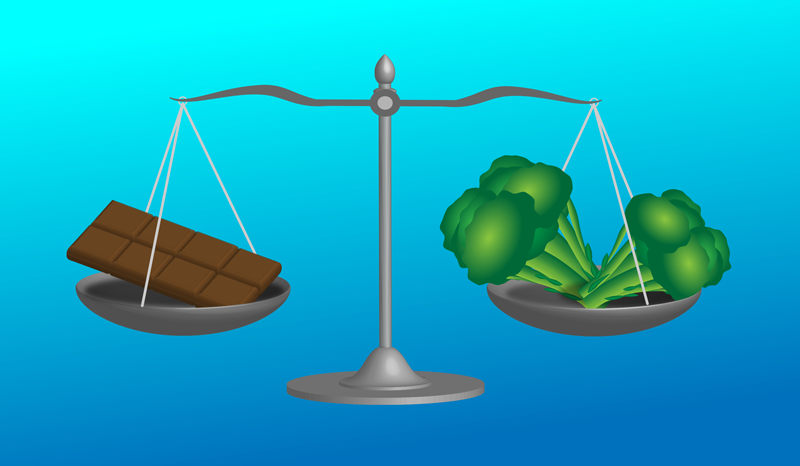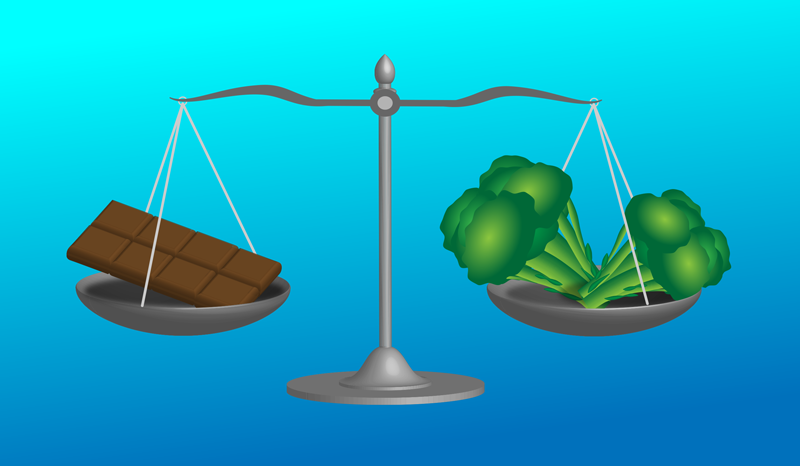Defending Thermodynamics in a Diet Debate
Not all calories are equivalent, say some nutrition experts, because the human body extracts energy differently from different types of food. A related concern in the field is that diet advice based on the first law of thermodynamics is inappropriate. However, these claims are countered by those studying human metabolism, who point to experiments that show that the calorie counts on food packaging correctly account for the differences between foods. Both camps agree that thermodynamics has earned a bad reputation in diet science, thanks to certain myths about weight loss, but they disagree on whether that reputation is deserved.
“A calorie may not be a calorie” was the message from a talk at the Physics of Food Manufacturing Conference held in January in Chipping Campden, UK. Speaker Andrew Preece is a physicist turned nutritional therapist who works part-time for the British security and defense contractor QinetiQ. Two heads of broccoli have the same calorie content as a chocolate bar, but they have different effects on weight gain, according to Preece. This calorie inequivalence, he says, is ignored in nutritional advice that focuses on calorie counting and on energy conservation as enshrined in the first law of thermodynamics.
“A calorie is of course a calorie,” says Kevin Hall, who trained as a physicist and currently conducts experiments and develops mathematical models for metabolism and body weight regulation at the National Institutes of Health in Maryland. Hall agrees that different macronutrients—think fats versus carbohydrates—have very different effects on the body, but he strongly disagrees with Preece’s claim. If the question is just about the number of calories burned by the body, rather than stored as fat, it’s “practically the same” for two foods having the same calorie rating, regardless of their fat or carb content, he says.
In experiments where people are fed meals with identical numbers of calories but different carb and fat contents, results show that the body burns nearly the same amount of energy. The models predict the same outcome. “We’re talking about differences on the order of [just] tens of calories a day in people whose diet is tightly controlled,” Hall says. “We can pretty confidently say there doesn’t seem to be much effect.” Of course, carbs and fats affect the body differently in many other ways, such as with their power to satiate, but their impacts on body fat per calorie are essentially the same.
Hall’s models account for the various metabolic reactions that occur in the body associated with food consumption and energy expenditure. The models incorporate thermodynamics and are set up to replicate the experiments that he and his team run in the lab. Slashing the number of carbs in a diet, for example, triggers the body to make glucose from non-carbohydrate sources, such as the glycerol that’s contained in fat tissue and in certain amino acids. These different reaction pathways can all be monitored using radioactive tracers, allowing researchers to accurately determine how metabolic pathways and energy consumption change with diet composition.
Do the Laws of Thermodynamics Apply to the Human Body?
At first glance, the laws of thermodynamics may seem inappropriate for modeling energy fluxes through the human body, as the body is not a closed, isolated system. “Living organisms are not in equilibrium,” so thermodynamics is not relevant, says Richard Feinman, a biochemist at the State University of New York Health and Science Center at Brooklyn, who also agrees with the “calorie is not a calorie” point-of-view. He argues that even if the oxidation pathways for different macronutrients use the same total energy, they still generate different amounts of work and heat and thus their calories are inequivalent.
This line of argument is erroneous, says Dale Schoeller, who studies metabolism and nutrition at the University of Wisconsin in Madison. He notes that the human feeding experiments conducted to determine the calorie content of foods factor in variations in how the body handles different macronutrients. These numbers are the ones used to calculate the values that appear on the sides of cereal boxes, for example. “It’s not a perfect number; it varies a few percent between individuals due to differences in their metabolisms,” Schoeller says. But it’s close to being spot on.
The feeding experiments also effectively treat the body as a closed system by measuring all the energy inputs and outputs, heat generated, and work done. The pathways are complex, but if you correctly measure them and account for them in models, then the laws of thermodynamics fit, Hall says.
“Of course, the laws of thermodynamics fully apply to living organisms,” says Marko Jusup, a physicist at the Tokyo Institute of Technology who develops models to describe myriad biological and ecological puzzles, from the spread of malaria to the growth of bluefin tuna. His models for the life of a tuna, for example, use energy balance arguments from thermodynamics to successfully predict the growth and reproduction rates of the fish as it transforms from an embryo to an adult.
The 3500 Calorie Myth
Jusup doesn’t understand why there is any debate over whether the laws of thermodynamics apply to humans, but he acknowledges that one needs to be careful when using the laws to make predictions. “Using them to provide dietary or nutritional advice is, in a sense, akin to using a wall clock to measure milliseconds,” he says. Hall echoes this sentiment, saying that applying the laws of thermodynamics to weight-loss advice can lead to confusion. He highlights the “3500 calorie rule” as a quintessential case. Preece also mentioned this rule as a source of his concern.
The 3500 calorie rule—enshrined in nutrition textbooks and dieting websites—states that for every 3500 calories you shed from your diet, you’ll lose a pound of body fat. But the data don’t match up, and this failure has led some to question the validity of any nutrition or weight-loss model involving energy conservation.
The 3500 calorie rule originates from work by American physician Max Wishnofsky. In 1958 he calculated that the amount of energy stored in a pound of fat tissue is roughly 3500 calories [1], which he then claimed is the amount a person should forego to shed a pound of fat. But there are two problems with this thinking, Hall says. First, the calculation assumes that only fat disappears when you lose weight, which is untrue. Second, it assumes that the energy expenditure of the body remains constant, whereas studies show that the body adapts to its lighter load by burning fewer calories. You have to cut increasing numbers of calories to lose each additional pound.
Hall thinks that the rule gained traction because it’s easy to remember, and, on the timescale of a few weeks, the predictions roughly pan out. “People like simplicity,” Hall says.
Hall says that he and others have made headway in educating physicians and dieticians about the equivalence of calories from different macronutrients and also about the 3500 calorie rule. For example, they have developed tools that allow physicians to make more accurate predictions. Hall’s software, the NIH Body Weight Planner, encodes a simplified version of his energy flux model and can be used by patients to predict the calorie reduction necessary to reach a target weight. “The website has been used by millions of people, so the message is getting out there,” he says. But, he adds, diffusing dieting myths in the wider public is a whole different ball game.
–Katherine Wright
Katherine Wright is a Senior Editor for Physics.
Correction (29 April 2019): This story has been updated because an earlier version of the text was published by accident.
References
- M. Wishnofsky, “Caloric equivalents of gained or lost weight,” Am. J. Clin. Nutr. 6, 542 (1958).







